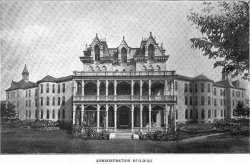St. Joseph State Hospital
| St. Joseph State Hospital | |
|---|---|
 | |
| Established | 1872 |
| Construction Began | 1874 |
| Opened | 1874 |
| Current Status | Active |
| Building Style | Kirkbride Plan |
| Location | St. Joseph, MO |
| Peak Patient Population | 3,000 in the 1950s |
| Alternate Names |
|
Contents
History
The story begins in 1872 when Missouri’s State Legislature approved $200,000 for the building of a Lunatic Asylum and St. Joseph citizens convinced the legislature to locate it just east of their city. Opening its doors on November 9, 1874, the hospital was called the State Hospital for the Insane No.2, or more familiarly named the Lunatic Asylum #2. Beginning with 25 patients, the first hospital superintendent described the institution as "the noble work of reviving hope in the human heart and dispelling the portentous clouds that penetrate the intellects of minds diseased.” And so it was for the next 127 years.
In no time at all the hospital’s 275 beds filled when relatives could no longer handle the special needs of family members with mental illness. Soon, an additional 120 beds were added, then another 250, then more and more over the years, as the hopelessly mental ill poured through their doors. In the hospital’s early years, the asylum was a self-sufficient institution where the patients worked on a farm, raising crops and livestock, to provide food for the facility. Allegedly, the hospital needed only to purchase salt and sugar to supplement their food provisions.
The hospital continued to be referred to as the State Lunatic Asylum #2 until 1899, when it gained the name the St. Joseph State Hospital. By the early 1950s, the facility had grown to nearly 3,000 beds and housed some of the most criminally insane individuals in the state, as well as those that could be rehabilitated, and others who were merely depressed. According to the museum, a few of these patients were just mildly depressed individuals who were dumped there by annoyed relatives. With modern medications, more and more patients began to return to society. Throughout its history, the hospital underwent a series of experimental treatments for its patients, some of which sound more like a cause rather than a cure for insanity.
In 1967, a museum was started in a ward of the St. Joseph State Hospital by a man named George Glore, a lifetime employee of the Missouri Department of Mental Health. Beginning with several full-sized replicas of 16th, 17th and 18th century treatment devices that were created for a mental health awareness exhibit, he soon began to look for other items that would illustrate how the treatment of mental illness had progressed over the years. George Glore spent the larger part of his 41 year career with the Missouri Department of Mental Health in developing the largest collection of exhibits featuring the evolution of mental health care in the United States. Glore retired from government service in the 1990s.
By the early 1990’s the majority of the patients of the asylum had been released back into society with the help of modern medications. In August, 1994, the state of Missouri approved a bond that allowed for the large asylum campus and hospital to be converted into a correctional facility. By July, 1997 a new state-of-the-art building was completed across the street from the original campus and the new Northwest Missouri Psychiatric Rehabilitation opened with 108 beds.
It was also in 1997 that Glore’s Psychiatric Museum was forced to move from the campus and soon relocated to a 1968 building that once served as a clinic for patients at the mental hospital, which now sits right outside the prison fence. The Western Reception, Diagnostic and Correctional Center opened on the old asylum campus in 1999, now confining over 1,800 inmates.[1]
Images of St. Joseph State Hospital
Main Image Gallery: St. Joseph State Hospital

